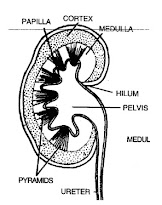(a) The diagram given below represents an organ system in the human body. Study the same and answer the questions that follow: [5 marks]
(i) Identify the system.
(ii) Label the parts marked 2 and 4. Mention the function of part 5.
(iii) Name the structural and functional units of the part marked 1.
(iv) What is the fluid that accumulates in part 3? Which is the main nitrogenous waste present in it?
(v) Draw a neat, labelled diagram showing the longitudinal section of part 1.
Solution:
This question based on the Excretory System was asked by ICSE board in the year 2019. The question tested the knowledge of students on the Kidney diagram and function of each part of the excretory system.
Let's begin with solving the above mentioned questions:
ANSWERS:
(i) Human Excretory System
(ii) Labeling:
- Part 2 --> Ureter
- Part 4 --> Sphincter
- Part 5 --> Urethra
The function of Urethra is to transport urine from the urinary bladder to the exterior of the body.
When sphincter muscles located at the opening of urinary bladder relaxes due to impulse from nervous system, the urine collected in the urinary bladder passes into the urethra and is expelled out of the body through urinary meatus by a process called micturition.
Ureter --> Urinary bladder --> Urethra --> Urinary Meatus --> Urine expelled out of body
(iii) Part 1 is kidney and structural and functional unit of Kidney is Nephron.
(iv) Urine accumulates in Part 3 Urinary Bladder.
Main nitrogenous wastes present in urine are:
- Urea
- Creatinine
- Uric Acid
(v) Longitudinal section of Part 1 - Kidney
You may also like to read:






No comments:
Post a Comment